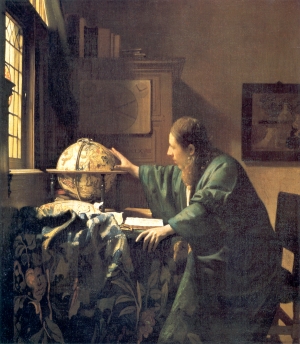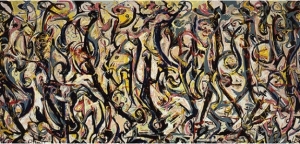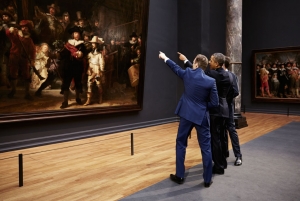|
Displaying items by tag: johannes vermeer
New research in the archives has made it possible to pinpoint the exact location of Johannes Vermeer’s world-famous The Little Street. Frans Grijzenhout, Professor of Art History at the University of Amsterdam, consulted seventeenth-century records that had never before been used for this purpose and clearly indicate the site of The Little Street in Delft. The discovery of the whereabouts of Vermeer’s The Little Street is the subject of an exhibition running from 19 November 2015 to 13 March 2016 in the Rijksmuseum. It will then transfer to Museum Prinsenhof Delft.
Pieter Roelofs, curator of seventeenth-century paintings at the Rijksmuseum, said: ‘The answer to the question as to the location of Vermeer’s The Little Street is of great significance, both for the way that we look at this one painting by Vermeer and for our image of Vermeer as an artist.’
The Rijksmuseum in Amsterdam has lent one of its great treasures—Johannes Vermeer's Woman in Blue Reading a Letter (c. 1663)—to the National Gallery of Art in celebration of the 20th anniversary of the landmark Johannes Vermeer exhibition, which opened here in November 1995 before traveling to the Royal Cabinet of Paintings Mauritshuis, The Hague, in March 1996.
This luminous masterpiece, recently restored at the Rijksmuseum, will be displayed through December 1, 2016, in the Dutch and Flemish Cabinet Galleries. It will hang with Vermeer paintings from the Gallery's own collection, including Woman Holding a Balance (c. 1664) and Girl with a Red Hat (c. 1665/1666)—the latter newly returned after being featured in Small Treasures, an exhibition shown in Raleigh, North Carolina, and Birmingham, Alabama—as well as Girl with a Flute (1665–1675), attributed to Vermeer.

The Museum of Fine Arts, Boston, has announced loans of important paintings by Johannes Vermeer and Rembrandt van Rijn for its upcoming landmark exhibition "Class Distinctions: Dutch Painting in the Age of Rembrandt and Vermeer" (October 11, 2015–January 18, 2016). Vermeer’s "The Astronomer" (1668) will be on loan from the Musée du Louvre in Paris, while the artist’s "A Lady Writing" (about 1665) will be on loan from the National Gallery of Art in Washington, DC. Works by Rembrandt in the exhibition will include "The Shipbuilder and his Wife" (1633) on loan from Her Majesty Queen Elizabeth II and the full-length, life-size "Portrait of Andries de Graeff" (1639) from Museumslandschaft Hessen Kassel in Germany. They will join the two seated full-length portraits by Rembrandt from the MFA’s collection, "Reverend Johannes Elison" and "Maria Bockenolle" (both 1634).
"A Lady Writing" portrays a privileged woman engaged in the art of letter writing, associated in 17th-century Holland with a certain level of education and wealth. Belonging to the same elite world, "The Astronomer" represents a “gentleman amateur” engaged in scientific inquiry that had relevance to the maritime navigation crucial to the mercantile interests of the young country.
Museums do not usually like surprises, but the Minneapolis Institute of Arts (MIA) is planning an entire year’s worth of them. In honor of its centennial, the MIA is unveiling a series of high-profile international loans and public art projects without warning. The first birthday surprise, unveiled today, is "Woman Reading a Letter," around 1663, by Johannes Vermeer, which is on loan from the Rijksmuseum in Amsterdam until April 19.

The Frick’s Center for the History of Collecting announces a new book series with the publication of its first volume, "Holland’s Golden Age in America: Collecting the Art of Rembrandt, Vermeer, and Hals." This series, entitled The Frick Collection Studies in the History of Collecting, is co-published with the Pennsylvania State University Press, and will ultimately cover a broad range of art collecting, reflecting the Center's reach well beyond the parameters of the Frick's own scope to include topics on modern and non-western art. Comments Inge Reist, Director of the Center, “We aim to encourage new scholarship in this young field of art history through our annual acclaimed symposia and ongoing fellowship program, much of which leads to new publications. Complementing that activity is this series that enables the Center to make its own contribution to the growing bibliography on the history of collecting in America.” This and future volumes are drawn from papers given at the Center’s symposia. Upcoming books from recent events include "A Market for Merchant Princes: Collecting Italian Renaissance Painting in America" (February 2015), edited by Inge Reist; "Going for Baroque: Americans Collect Italian Paintings of the 17th and 18th Centuries," edited by Edgar Peters Bowron; and "The Americas Revealed: Collecting Colonial and Modern Latin American Art in the United States," edited by Edward Sullivan.
Americans have long had an interest in the art and culture of Holland’s Golden Age. As a result, the United States can boast extraordinary holdings of Dutch paintings. Celebrated masters such as Rembrandt, Johannes Vermeer, and Frans Hals are exceptionally well represented in museums and private collections, but many fine paintings by their contemporaries can be found here as well.
Since it opened to the public in 1822, the Royal Picture Gallery Mauritshuis has been one of those quiet gems, set in a 17th-century classical townhouse in the center of this patrician city and frequented by lovers of Dutch Golden Age painting. But when it closed for a renovation and expansion two years ago, and a selection from its collection went on tour, Mauritshuis gained an instant celebrity it had never had before.
Wherever the paintings went, millions of people followed, enduring long lines to see two works in particular: Vermeer’s doe-eyed “Girl With a Pearl Earring” (circa 1665), which has become one of the most famous paintings in Western art, and Carel Fabritius’s “The Goldfinch” (1654), a mere slip of a work — about 13 inches by 9 inches — but a giant hit because of Donna Tartt’s best seller of the same title. Also in that show was a sampling of works by Rembrandt and Rubens, Hals and Steen, but they were just the icing on top.
Christie’s auction house says science has confirmed that a disputed painting is the work of Dutch master Johannes Vermeer. The painting could fetch 8 million pounds ($13 million) when it is sold next month.
“Saint Praxedis” is believed to be the earliest surviving work by the 17th-century artist, but there has long been a question mark over its authenticity.
The work was tentatively attributed to Vermeer after it appeared in an exhibition at New York’s Metropolitan Museum in 1969, and the authorship was reinforced in 1986, when leading Vermeer scholar Arthur Wheelock argued it was authentic.
Thievery of fine art is nothing new. One of the more infamous heists involved the 1990 theft of The Concert, a masterpiece by Dutch painter Johannes Vermeer, taken from a Boston museum. The most spectacular heist of a painting may still be Leonardo da Vinci’s The Mona Lisa, seized from the Louvre in 1911 and then returned two years later.
Dallas sculptor Michael Christopher Matson knows all about those stories. He just never thought it would happen to him. It did.
Matson, 42, has worked as an artist “my entire adult life.” He reveled in the fact that, last June, he was asked to showcase his trio of large sculptures outside in a show called “Steel and Light” at one of Dallas’ premier venues, Kirk Hopper Fine Art. The rust-colored pieces stood proudly 7, 8 and 9 feet tall, made for the outdoors.

The J. Paul Getty Museum in Los Angeles announced that its exhibition dedicated to Jackson Pollock’s recently restored “Mural,” has given the museum a welcome boost in attendance. In March, 127,466 patrons visited the Getty, an increase of 3% from the same month in 2013. Last year, the museum also saw an unusually high attendance rate due to an exhibition of Johannes Vermeer’s “Woman in Blue,” which was on loan from the Rijksmuseum in Amsterdam. From 2010 to 2012, average March attendance at the Getty hovered around 97,000.
“Mural," a stunning oil-on-canvas measuring more than 8 feet tall and nearly 20 feet long, recently underwent a year-long restoration at the Getty. Conservators removed a layer of varnish from “Mural,” which now appears much brighter and closer to its original appearance. The work, which was painted in 1943 for the well-known art collector Peggy Guggenheim, represents a turning point in Pollock’s career in which he gravitated towards the abstract expressionist characteristics that define his seminal “drip” paintings. The work belongs to the University of Iowa Museum of Art, which received it as a gift from Guggenheim in 1951.
The Pollock show opened at the Getty on March 11 and details the conservation of the painting. During the first week of the exhibition, the Getty welcomed 29,374 visitors, a 25% increase from the first week of the month. The last week of March saw a 46% jump from the first week of the month.
"Mural" will remain on view at the Getty through June 1.

While in Amsterdam for the Nuclear Security Summit, President Obama visited the city’s celebrated Rijksmuseum, the first ever visit by a serving U.S. President to the museum. The Rijksmuseum’s General Director, Wim Pijbes, gave the President a tour in the Gallery of Honour, where masterpieces by Frans Hals, Jan Steen, and Johannes Vermeer are exhibited. The Gallery of Honour leads to a designated area where Rembrandt’s greatest masterpiece, “The Night Watch,” is displayed.
The Rijksmuseum re-opened to the public in April 2013, following a ten-year renovation. The project, which cost around $841 million, included restoring all eighty of the museum’s galleries with their original decorations and paintings and outfitting them with the most up-to-date technologies. Since its re-opening, nearly 3 million patrons have visited the museum, making it one of the most successful transformations of a museum in history.
Other notable figures who have visited the Rijksmuseum include Theodore Roosevelt, Lady Bird Johnson, and Hillary Clinton.
|
|
|
|
|